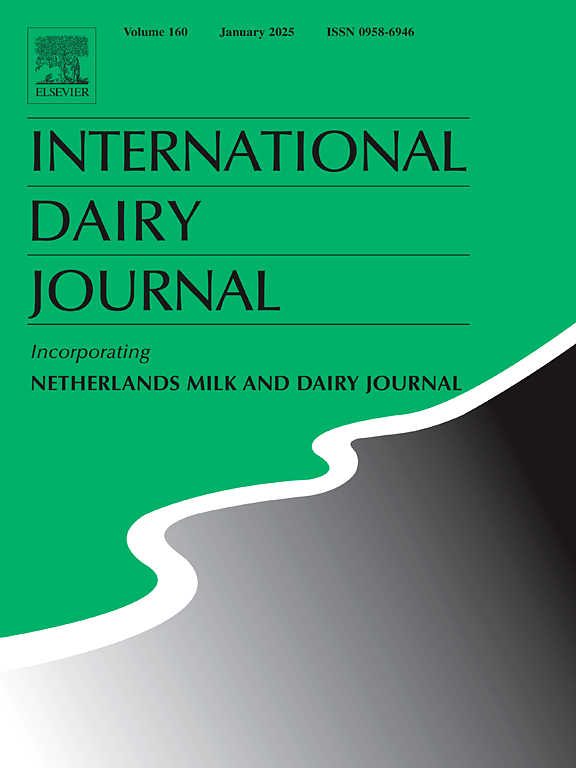Compositional characterisation of colostrum and proline rich polypeptides of indigenous cattle (Bos indicus family) and Holstein Friesian (Bos taurus) and their crossbred Karan Fries cattle
IF 3.1
3区 农林科学
Q2 FOOD SCIENCE & TECHNOLOGY
引用次数: 0
Abstract
Proline-rich polypeptides (PRPs) are polypeptides characterized by a high proportion of hydrophobic amino acids (∼45 %) and over 20 % proline, with molecular weights ranging from 0.5 to 17 kDa. Colostrum is the only source of PRPs; therefore, excess colostrum could be utilized for PRPs production. These PRPs mostly originate from caseins, such as β-casein and α-casein. The role of PRPs in preventing pathological processes in the central nervous system is well established and many formulations included PRPs or colostrum in their medications. Present study envisages composition of colostrum and quantify PRPs content across select indigenous breeds with exotic breed (Holstein Friesian, HF) and one cross breed of HF and Tharparkar (Karan Fries, KF), with time period after parturition. Furthermore, PRPs were characterized using SDS-PAGE, HPLC, amino acid composition, and LC-ESI-MS/MS to understand molecular weight distribution and sequential changes. The HF and Sahiwal breed consistently exhibited the higher PRPs yields at 12, 24 and 36 h postpartum. HF (114.10 ± 19.41 mg/L of colostrum) and Sahiwal (102.20 ± 2.35 mg/L of colostrum) showed the highest PRPs concentrations at 12 h, followed by a decline, highlighting colostrum collected within 24 h of parturition as the optimal PRPs source. Indigenous breeds such as Sahiwal (24.50 %), Gir (21.91 %), and Tharparkar (22.30 %) has shown higher concentrations of proline compared to the crossbred KF (17.49 %) and the exotic HF (18.25 %).
土着牛(波斯indicus科)和荷斯坦弗里马(波斯金牛)及其杂交卡兰弗里牛初乳和富含脯氨酸多肽的组成特征
富含脯氨酸的多肽(PRPs)是一种分子量在0.5 ~ 17 kDa之间的多肽,其特征是高比例的疏水氨基酸(~ 45%)和超过20%的脯氨酸。初乳是PRPs的唯一来源;因此,多余的初乳可以用于生产PRPs。这些PRPs主要来源于酪蛋白,如β-酪蛋白和α-酪蛋白。PRPs在预防中枢神经系统病理过程中的作用已得到证实,许多制剂在其药物中含有PRPs或初乳。目前的研究设想了在分娩后的一段时间内,选择本土品种与外来品种(荷斯坦弗里西亚,HF)和一种HF与塔帕卡尔杂交品种(卡兰弗里西亚,KF)的初乳组成和量化PRPs含量。利用SDS-PAGE、HPLC、氨基酸组成、LC-ESI-MS/MS等方法对PRPs进行表征,了解其分子量分布及序列变化。HF和Sahiwal品种在产后12、24和36 h均表现出较高的PRPs产量。HF(初乳114.10±19.41 mg/L)和Sahiwal(初乳102.20±2.35 mg/L)在12 h时PRPs浓度最高,随后下降,提示分娩24 h内收集的初乳是最佳的PRPs来源。本地品种如Sahiwal(24.50%)、Gir(21.91%)和Tharparkar(22.30%)的脯氨酸含量高于杂交品种KF(17.49%)和外来品种HF(18.25%)。
本文章由计算机程序翻译,如有差异,请以英文原文为准。
求助全文
约1分钟内获得全文
求助全文
来源期刊

International Dairy Journal
工程技术-食品科技
CiteScore
6.50
自引率
9.70%
发文量
200
审稿时长
49 days
期刊介绍:
The International Dairy Journal publishes significant advancements in dairy science and technology in the form of research articles and critical reviews that are of relevance to the broader international dairy community. Within this scope, research on the science and technology of milk and dairy products and the nutritional and health aspects of dairy foods are included; the journal pays particular attention to applied research and its interface with the dairy industry.
The journal''s coverage includes the following, where directly applicable to dairy science and technology:
• Chemistry and physico-chemical properties of milk constituents
• Microbiology, food safety, enzymology, biotechnology
• Processing and engineering
• Emulsion science, food structure, and texture
• Raw material quality and effect on relevant products
• Flavour and off-flavour development
• Technological functionality and applications of dairy ingredients
• Sensory and consumer sciences
• Nutrition and substantiation of human health implications of milk components or dairy products
International Dairy Journal does not publish papers related to milk production, animal health and other aspects of on-farm milk production unless there is a clear relationship to dairy technology, human health or final product quality.
 求助内容:
求助内容: 应助结果提醒方式:
应助结果提醒方式:


